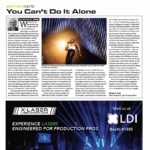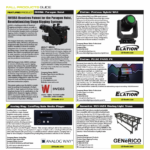The most comprehensive energy exhibit in the world, the Wiess Energy Hall, opened Nov. 20 in the Houston Museum of Natural Science (HMNS). More than two years in the making, the highlight of the exhibit is Energy City, a 2,500-square-foot 3D landscape designed and fabricated by Paul Bernhard Exhibit Design and Consulting (PBE), the design company selected to create the
Wiess Energy Hall.
Scaled at 1/150, Energy City represents Houston, the surrounding Gulf coastal waters and the terrain of Southeast and Central Texas. The project uses new projection mapping technologies to bring to life the energy value chain through animation, as the entire tableau cycles from day to night.
After a worldwide search, PBE chose RabCup to bring Energy City to life. As pioneers in 3D projection mapping and experts in both project management and video solutions, RabCup founders A.J. Freysteinson and Justin Fortier got the nod for this assignment. The two friends began working together 16 years ago. Both launched their careers working in theater, and continued into broadcast, film, live event, music touring, festivals, corporate events and production design. In 2015, they formed RabCup.
“PBE is an amazing design firm out of Austin,” says Fortier. “The founders have worked in the museum world for over 25 years and have also worked frequently on movie sets and props. Collaborating with them on this project for the last two and a half years has truly been an honor. PBE created an astonishing canvas for Energy City.”
In Hamburg, Germany, the world’s largest miniature train track installation served as the inspiration for HMNS leadership to develop Energy City with PBE. Called Miniatur Wunderland, more than 150 employees and 60 computers keep this tourist attraction open and available to over one million visitors a year. But because Energy City is expected to operate for at least 10 years, PBE wanted a design and technology that would not need a full staff of technicians to operate.
“This was the first time ‘bleeding edge’ projection mapping of such an intricate scale has been done,” Fortier says. “The white model is 80 feet long, 30 feet wide and 16 feet high,” he adds. “There were a lot of unknowns; however, a boom in technology at the time, with laser projectors coming into an affordable and better-packaged range, helped solve some concerns.”
Mission Improbable
“We have known Nigel Sadler for a long time and have worked with him, Cory Froke, and Green Hippo on many projects previous to this,” adds Freysteinson, “so we have a very good working relationship. They initially told us they weren’t sure it could be done.”
At the time, Green Hippo was in the process of an upgrade of software for their new release. Faced with the challenges the project brought forth, Green Hippo began testing a new optimized render pipeline to address the demands of this project.
“The model was essentially designed by the time we got to the point of actually figuring out how best to projection-map the whole thing, so there were some interesting challenges from the start,” notes Cory Froke, product specialist for Green Hippo, “not the least of which was how to deal with a 1.6 gigabyte 3D model consisting of over 1,600 individual buildings and over 10 million vertices.”
“There were a lot of tech-sparring conversations over what was even possible,” says Fortier. “We had the technical side with the projectors and enlisted Cory (a.k.a. “SuperTech”) to implement on the server and system design side.”
What became immediately apparent was that existing automated alignment systems were not going to be feasible, either technically or financially. Due to the complexity of the model, this approach would have required a minimum of one camera per projector, likely even more, simply due to the resolution limitations of approachable cameras. So the R&D began on an alternative, affordable alignment system that can stand on its own, completely independent of the projection system.
Most of the coding and development work was done by the development team in London, while the majority of the testing was done by Froke and Sadler in the U.S. Specification writing of how it needed to function, and what information was needed — both into and out of the system — “was easily the hardest part of this aspect of the project,” says Froke.
Traditional automated alignment systems rely on cameras sampling vertical and horizontal lines, then “warping” the projectors’ feed to best fit onto the model — essentially making straight lines coming out of the projector “read” as straight lines when they hit the model surfaces.
Green Hippo created SHAPE Auto-Alignment —a camera-less, affordable, automated alignment system that can align and blend all 32 projectors at the touch of a button in minutes. There are 168 fiber optic light sensors embedded into the model, using over seven kilometers of plastic sensor fiber routed back to custom-built SHAPE Processing Nodes, which make this possible. Green Hippo’s component-based structure allowed the team to remove any unnecessary features, giving the render engine more resources to deal with playing that much video seamlessly.
“We do a structured light pattern from every projector, reading the values of the light sensors at every pattern,” Froke notes. “Because we know where the sensors are in 3D space, we can then calculate where the projector is in 3D space. The projector for us almost acts like a camera — whatever part of the model it can ‘see’ is the part of the model that it will display.”
A Landmark Achievement
With more than 13 million vertices in the model and 128-megapixel content delivery resolution, Energy City is one of the most intricate projection mapping projects ever done. Sixty frames per second (fps) is pretty much the new standard. Currently, Hippotizer is the only product on the market that can move that much content at that frame rate without dropping any content. To accomplish the 60fps playback, Froke deployed a system of nine Green Hippo Hippotizer Taiga DP with two Hippotizer Amba machines serving as “management” machines.
“It is a real interesting bandwidth problem,” Froke says. “We had to remove some features from our render pipeline to optimize that flow while being cognizant of not losing too much functionality. Rendering takes time, so it’s a balancing act to find out how much can we cut out to play back these insanely large files without losing the real-time control for things like color correction and grading.”
Equally important to this project was content. RabCup selected Radar to produce the animated media for Energy City. To create all that custom content, the team included 30 people, including 12 animators, four producers and four content writers, with Radar also working closely with PBE writers and producers to created the custom content for this installation. Over the course of the project, Radar rendered more than 30 terabytes worth of content. Final animations show eight different energy systems and stories, as well as a 24-hour time-lapse of the city itself.
“We’ve used a lot of content companies over the years” says Freysteinson. “For this project, we were looking for someone in our backyard that we could sit down with daily. After interviewing four or five companies, Radar was the best fit. They cared about the science and how we tell the story. We were all putting numbers to things that hadn’t been done before. Radar was right there with us, ready to ramp up into the unknown.”
“Instead of Radar building content for each projector, we are literally texturing the whole model,” Froke points out.
The whole show is cued by three Crestron units tied to a touch panel. Crestron also triggers the audio system, which then sends time code to everything else past the sync generators. The Hippotizer takes timecode frame-for-frame.
The exhibit features 30 minutes of custom content, a five-minute day-to-night sequence and eight Science modules. The 6.1 channel audio system with speakers spread across the 80-foot-wide model is designed to add to the immersive effect of the visuals.
The model features environmental sounds specific to a certain area so that, no matter where a viewer is standing, that area will have its own distinct sound. The exhibit has been credited as is an AV tour de force, delivering a unique experience every time you walk into the room.
“We go through VPN to access utility computers,” notes Froke. “The Hippotizer themselves are firewalled off from the world twice, just because we want to be very careful with the exhibit. Wireless webcams monitor the system 24 hours a day. These are Nest-Cams, which allow for talk-back with technicians onsite, should that be necessary.”
“One thing we’d love to say is we are proud to have our work showcased in such an admired museum; it calls for all of us to bring our best,” says Fortier. “It’s nice to have a legacy piece that is centered on education, teaching children, and is a first-in-the-world kind of thing.”
Freysteinson agrees. “Everything we’ve done in projection-mapping is there for a couple days. You unplug it, and its gone, and only remembered if you see a video on YouTube or somewhere. We’re excited about this because it’s taking the technology and everything we have worked with and turning it into something that exists for more than a day or two. It’s wonderment. It’s spectacle on fire.
“Working on a museum floor — going from concrete to a fully built-out, tech-heavy space, over the course of two years, while engaging some of the most creative people we have ever had the pleasure to be around — has made this experience one of the most exciting projects we’ve ever been a part of,” Freysteinson adds. “Particularly since it will be teaching kids for many years. Hopefully, they’ll see a spark in this beautiful thing inspiring them to be an astronaut or whatever they want to do. Maybe sometime in the future, I’ll be able to bring my own kid to experience it.”
Energy City Projection Team
- Creative Director: A.J. Freysteinson
- Technical Director: Justin Fortier
- Content Producer: Lisa James
- System Designer: Cory Froke
- Content Lead: Drew Lucas
- Technicians: Jason Hawk Hamilton, Robert Behounek
Energy City Project Stats:
- White Model Size: 80’ x 30’ x 19’ (WxDxH)
- Number of Buildings: 1,600
- Number of Vertices: 13+ Million
- Number of WUXGA Laser Projectors: 32
- Overall Resolution: 128,374,912 pixels
All buildings are covered a minimum of 270 degrees, with most buildings covered 360 degrees
- Video/Projection Gear
- 9 Green Hippo Hippotizer Taiga DP6 media servers
- 2 Green Hippo Hippotizer Amba units
- 8 Green Hippo Auto-Align 24ch sensor nodes
- 2 Green Hippo Auto-Align processing nodes
- 32 Vivitek DU8090Z laser projectors
- 32 Chief Manufacturing customized VPAU mounts
- 1 Lightware MX-FR80R Modular Router Frame (64 DVI inputs, 16 HDMI inputs, 40 fiber DVI outputs, 40 HDMI outputs)
- 32 Lightware 110-series DVI fiber receivers
- 1 MA onPC command wing w/onPC 8-Port node
- 1 Evertz 5601MSC master clock
- 1 Corning 4U CCH Fiber Cage (80 Simplex SC patch points, 48 duplex LC patch points)
- 1 Netgear XS-Series 10G network switch
- 4 Cisco SG500-series gigabit network switch
- 1 QNap 48TB NAS
- 2 Avocent HMX Series KVM advanced managers
- 15 Avocent HMX5100-series KVM transmitters
- 2 Avocent HMX5100-series KVM receivers
- 2 Avitech Titan9000 multiviewers
- 2 Brainstorm SR-112 “Distripalyzers”
- 2 Rosendahl Nanosync HD units
- 1 Crestron 3-series advanced control system
- 1 Crestron rackmount touch screen
Related Links:


